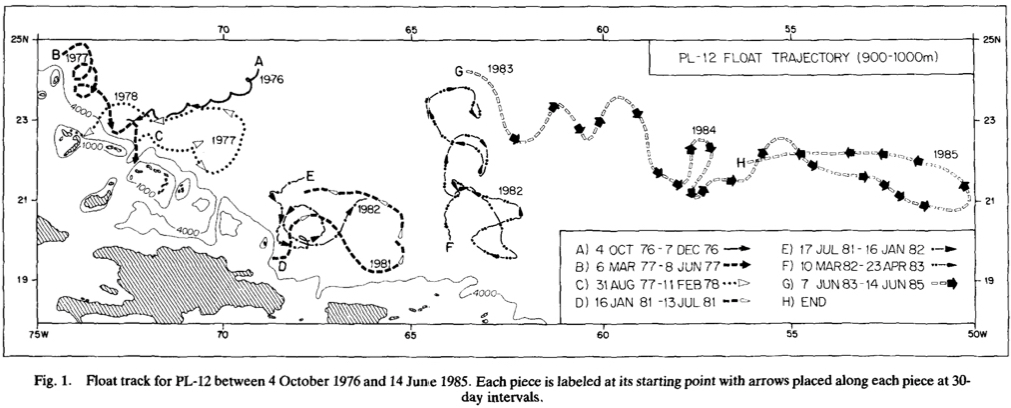The beauty of floats as they drift about is the rich variety of flow patterns they reveal whether of flows in fronts, eddies or just plain ambling about. The first long-lived SOFAR float we deployed revealed repetitive motions strongly suggestive of barotropic planetary wave motion with a roughly 80-day period. Trajectories can even exhibit ‘human’ qualities like when two floats take turns like a boy and a girl chasing each other. We found it useful to have group discussions about the trajectories, to unravel what can they tell us about the machinery of the ocean. Perhaps the most extreme or at least long-lived trajectory is that of float PL-12 launched in the meddy I described in a recent post. It took so many different turns during its 9-year life it seems appropriate to think of it as a restless wanderer. Today you can surely find similar stories in the Argo float archive, but this float was deployed in fall 1976, almost a half-century ago, back in the early days when we marveled at the variety of oceanic motion revealed by these new instruments.
The float lived way beyond its 2-3-year design life length. The obvious reason this happened is that it was not transmitting at full power. But it was putting out enough signal that it could be heard at the listening stations we had established to track it and other floats. In the Instrument section of the blog you’ll find brief descriptions of the SOFAR float and SOFAR float tracking systems.
It was deployed near the center of the meddy mentioned earlier. It made six loops before disappearing between some islands near Turks and Caicos two months later (A). Three months after that it emerged (B) and looped around another (or a fragment of the previous) eddy for 3 months before disappearing again. But then it remerged (C), this time loafing about offshore of Turks and Caicos for 5 months before again disappearing into the island chain. This time for good since we heard nothing more. Imagine our surprise when 3 years later we picked up its signals from where it emerged from Mona Passage between Hispaniola and Puerto Rico!

The 13-month long section (F) is rather curious. At the risk of over-interpreting the trajectory, it makes 3 curious east and south excursions as it drifts north – suggestive of wave-like motion. These may in some way be related to the float’s northward movement and thus increasing planetary voracity.
In stark contrast, consider the extended zonal displacements over the next two years (G). The float drifts nearly 15° to the east before turning back west at about the same latitude. We can’t prove it, but it seems plausible that these large zonal excursions reflect the movement of bands of water where their zonal scale is much larger than the meridional scale. This may reflect the effect of planetary vorticity constraining flow motion to lines constant latitude.
Owens, W.B., P.L. Richardson, W.J. Schmitz, H.T. Rossby, and D.C. Webb (1988). Nine-year trajectory of a SOFAR float in the Southwestern North Atlantic. Deep-Sea Res., 35, 1851-1857.